

2024
Embodied Carbon Action Plan
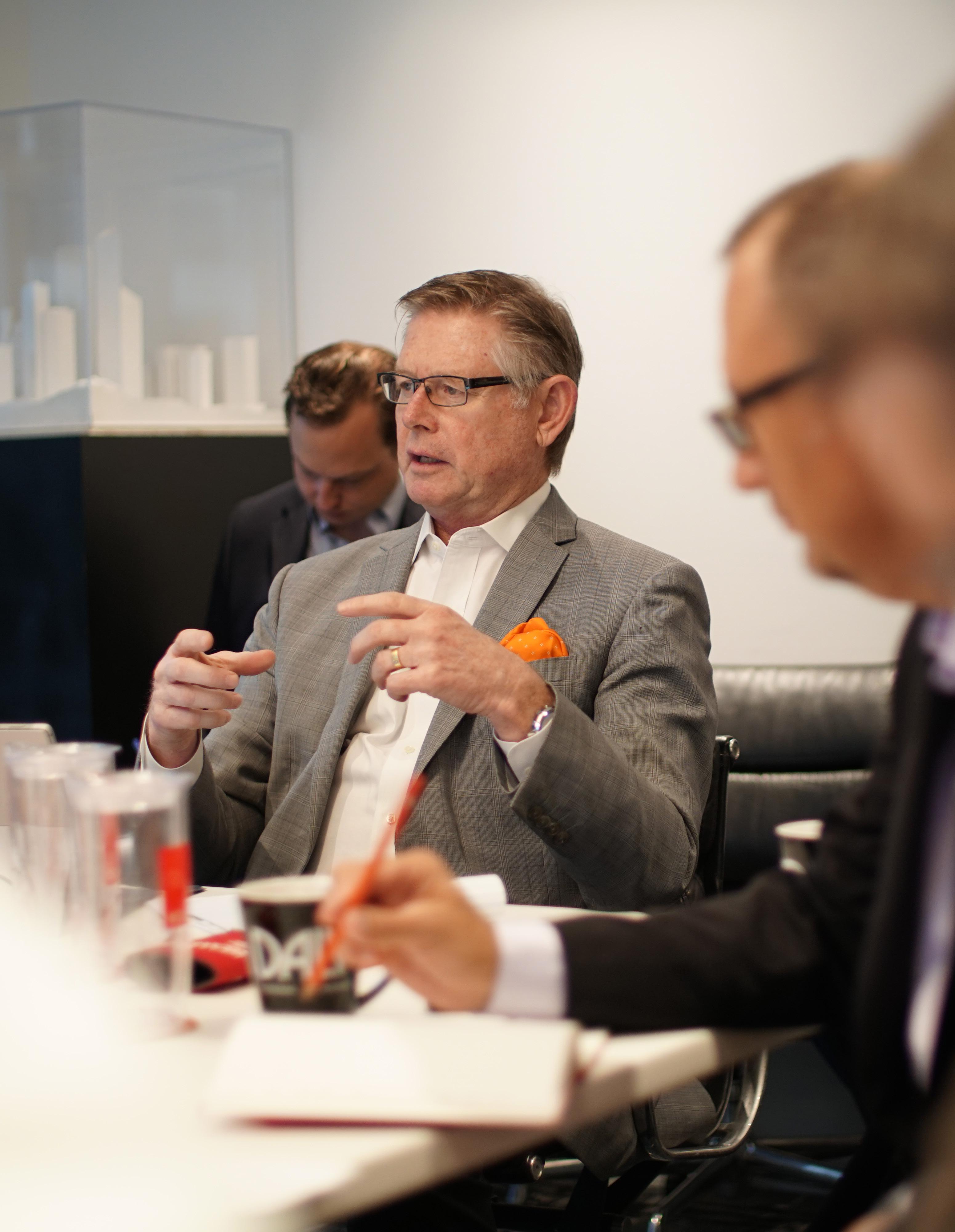

LEO A DALY is a global design firm that has operated for more than 100 years, driven by the belief that everything we do is for the enrichment of human experience. Our industry is facing environmental and social pressures and challenges — and that presents us all with an opportunity to chart a new path. Embracing the view that architecture must respond to the spirit of the age, our responsibility and our relevance lies in making the world a better place through work that responds to the challenges the era presents.
We must all give great consideration to how our work performs in our physical, social and economic environment — how it accommodates its program and purpose, benefits users, makes community, and fits within the natural environment, the city, the economy and time. Performance, as a measure of a building’s fit, is our focus and common design agenda. This agenda is not only our responsibility and contribution to the larger profession; it is at the core of a continual evolution that is essential to compete in the marketplace.
The SE 2050 pledge creates guideposts as we forge a path to a more sustainable future. Each piece of this action plan creates a step forward on that path, all working together to help us and our clients achieve that carbon reduction.
This report represents LEO A DALY’s contribution to the industry’s advancements in sustainability. Many thanks to the American Society of Civil Engineers’ Structural Engineering Institute for leading this effort. I’m excited to see the strides forward across our industry.
Sincerely,
 Steven A. Lichtenberger, AIA, NCARB, LEED AP President, LEO A DALY
Steven A. Lichtenberger, AIA, NCARB, LEED AP President, LEO A DALY
3
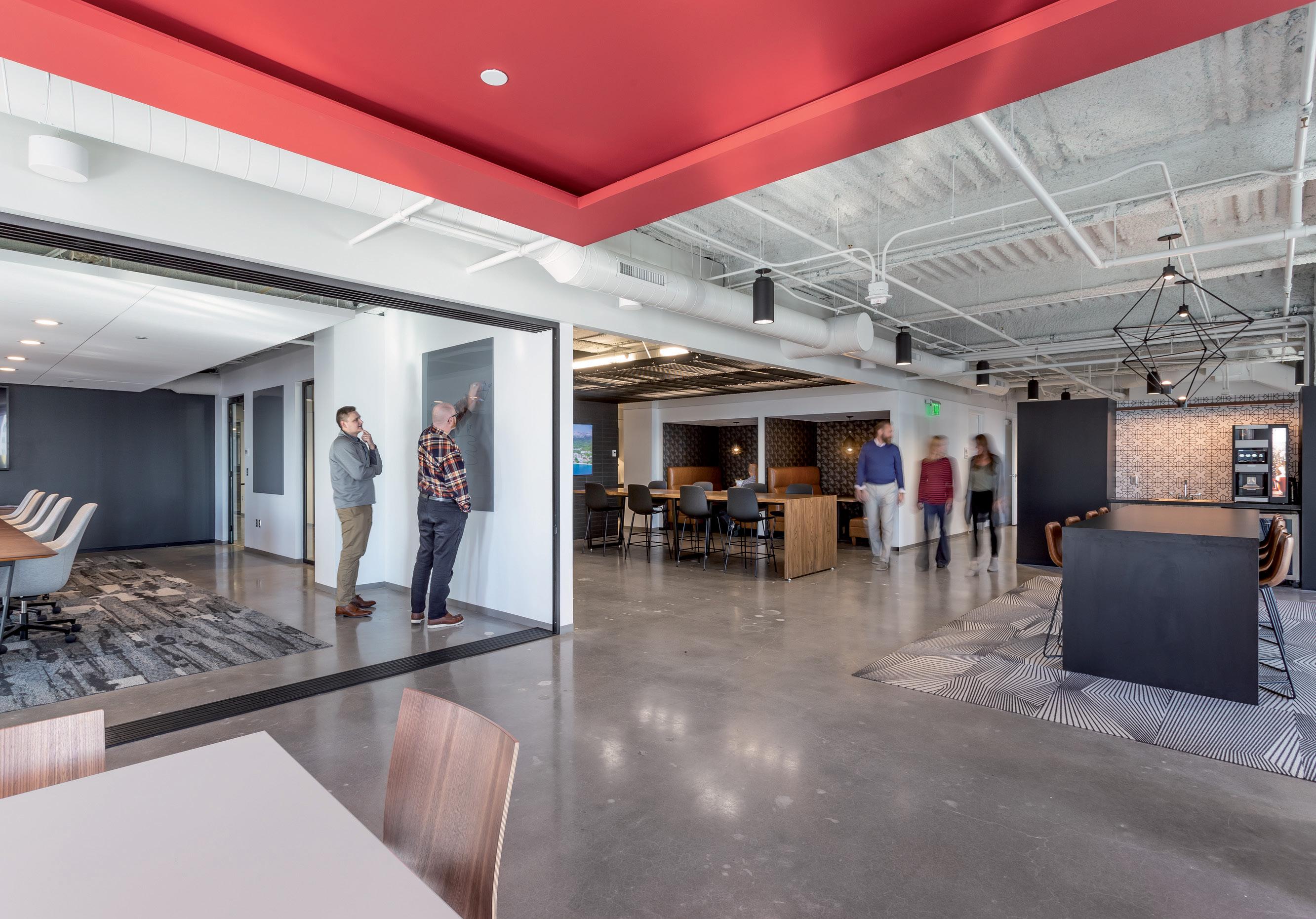
Executive Summary
At LEO A DALY, we believe that good design is, by definition, sustainable design. Over the last several years, we have systematically reworked our firm-wide design approach to place building performance as the defining factor in our understanding of design excellence. Our firm continues to pursue a balanced approach of considering both, embodied and operational carbon.
In 2022, we signed the SE2050 commitment, pledging to track, reduce, and ultimately aim to eliminate embodied carbon from our portfolio of work by 2050. With this step, we are making a public declaration that embodied carbon will join operational carbon as a defining interest in our design process. This will require significant effort over the next 26 years, and we are committed.
Over the past two years, we have begun to educate ourselves and our peers on the impact of embodied carbon. We are tracking, recording and reporting embodied carbon data by performing whole-building life cycle assessments. We are educating, and we are specifying low carbon impact materials in our design specifications. These efforts will help ensure LEO A DALY contributes to the industry-wide efforts towards our net-zero goals.
In the following report, you will learn about our efforts to-date and our future plans for educating, engaging, reporting and advocating for the elimination of embodied carbon in the built environment.
LEO A DALY Embodied Carbon Action Plan

About LEO A DALY
LEO A DALY’s diverse and creative teams combine planning, architecture, engineering and interiors expertise to offer a holistic response to our clients’ challenges. For more than 100 years, we’ve created places that inspire wonder, connect communities and enable great things. Our design approach is based in inquiry, focused on innovation and rooted in social and ecological responsibility.
Founded in 1915 by Leo A. Daly, Sr., LEO A DALY is consistently ranked among the top design firms in the world. LEO A DALY rose to national prominence for pioneering the use of interdisciplinary project teams: a “whole project” approach that ensures maximum efficiency, coordination and client satisfaction. Today, we continue a legacy of innovation and commitment to client satisfaction, creating exceptional projects that enhance and enrich the human experience.
Strong client relationships have helped LEO A DALY become a leader in the design of the built environment, and one of the largest planning, architecture, engineering, interior design, and program management firms in the world. Since 1915, we have had an unyielding focus on design excellence to create exceptional spaces that enhance and enrich the human experience. Our privately held practice has more than 400 design and engineering professionals in 9 studios worldwide. Our award-winning, diverse portfolio includes projects in a wide range of markets in more than 91 countries, all 50 US states, and the District of Columbia.
14
5
4
Structural Engineers
Employees with LEED/Fitwell/ WELL AP certifications
LEED Certified Projects
105
68
LEED Platinum Projects
Green Globe Certified Projects
global firm with
years of design experience practicing in 12 markets with studios in:
Dhabi . Atlanta . Dallas . Omaha
Angeles Miami Minneapolis
D.C. West Palm Beach 5
A
109
Abu
Los
Washington
Embodied Carbon
Manufacturing, transportation, installation and demolition of construction materials.
About SE 2050
As an industry, and as a firm, we recognize that designing buildings to operate more efficiently is not enough to keep global temperatures under the 1.5-degree threshold that scientists believe will enable us to avoid the most serious impacts of climate change. We must also reduce embodied carbon, defined as the carbon emitted in association with the extraction, manufacturing, transportation and end-of-life demolition of building materials.
SE 2050 is our commitment to doing that. The Structural Engineers 2050 Commitment Program (SE 2050) is a response to the SE 2050 Challenge issued in 2019 by the Carbon Leadership Forum (CLF). The program was developed by the Sustainability Committee of the Structural Engineering Institute (SEI) of the American Society of Civil Engineers (ASCE). Following this comprehensive program, we will take part in the substantive embodied carbon reductions targeted collectively by the structural engineering profession.
The basic aims of the Program are to:
• Educate the structural engineering profession on the best practices of sustainable structural design and construction that will lead to net zero embodied carbon by 2050;
• Engage in an embodied carbon tracking program within the structural engineering profession thereby enabling the establishment of appropriate embodied carbon reduction targets until net zero is realized;
• Report on the current embodied carbon impacts and trends of various structural systems for different regions throughout the country; and
• Advocate and communicate with clients, the design community, and the public to build an understanding about embodied carbon and impacts of the built environment.
LEO A DALY Embodied Carbon Action Plan
Illustrated by Stacy Smedley of Skanska
PLAN
1
Embodied Carbon Action Plan
Office action plan including supporting staff education efforts and internal SMQ and GWP tracking.
IMPLEMENT SHARE
2 3
Implementation and Accountability
Engage in sustainable goals of projects, specify low carbon impact materials and understand the GWP of each project using LCA methods.
Data Sharing and Tracking
Share GWP and SMQ data of structural systems for benchmark establishment and development of annual reduction targets.
SE 2050 Commitment Program
Asks structural engineers and structural engineering firms to accelerate the embodied carbon reduction in structural systems and materials through three main activities.
Energy
7
Operational Carbon Building
Consumption
Education Plan
Embodied carbon touches every project we do as a firm. Therefore, it’s imperative that every professional at LEO A DALY understand embodied carbon and be mindful of the effects their design decisions have on it.
Our initial embodied carbon education has focused on awareness. Our key messages are:
• Our design decisions affect not just our buildings and our clients, they affect the world, through our carbon footprint.
• We can all reduce embodied carbon.
• SE 2050 is geared toward structural engineers, however, we will leverage our integrated design practice to think about embodied carbon through architecture, interiors and mechanical, electrical and plumbing engineering.
We’ve made it a priority in our education efforts to break down the assumption that embodied carbon is solely the responsibility of structural engineers. Although structural elements are the biggest contributor to embodied carbon in a typical building, roughly 40-50 percent of embodied carbon comes from other disciplines. As an interdisciplinary design firm, we are committed to understanding not only the cost of structural carbon, but the role played by architecture and interior design as well. Working together, we can address it holistically.
Repetition has been important to our education efforts. At the beginning of 2020, an internal survey found that most employees were unfamiliar with the concept of embodied carbon. Today, after repeated exposure to the education efforts outlined below, we estimate 60 percent of designers across disciplines understand and appreciate embodied carbon. This percentage, and the actions related to it, will increase as we continue our education efforts.
We’ve undertaken a variety of measures to ensure our employees understand embodied carbon and that we stay on the forefront of new technology. We’ve hosted presentations and webinars across the 400-plus member firm. These range from introductory “Embodied Carbon 101” to in-depth technical presentations about designing to reduce embodied carbon emissions. Our GreenWorks group and structural engineers have received specific guidance to further advance their understanding. We’ve also launched a quarterly internal sustainability newsletter which includes embodied carbon education.
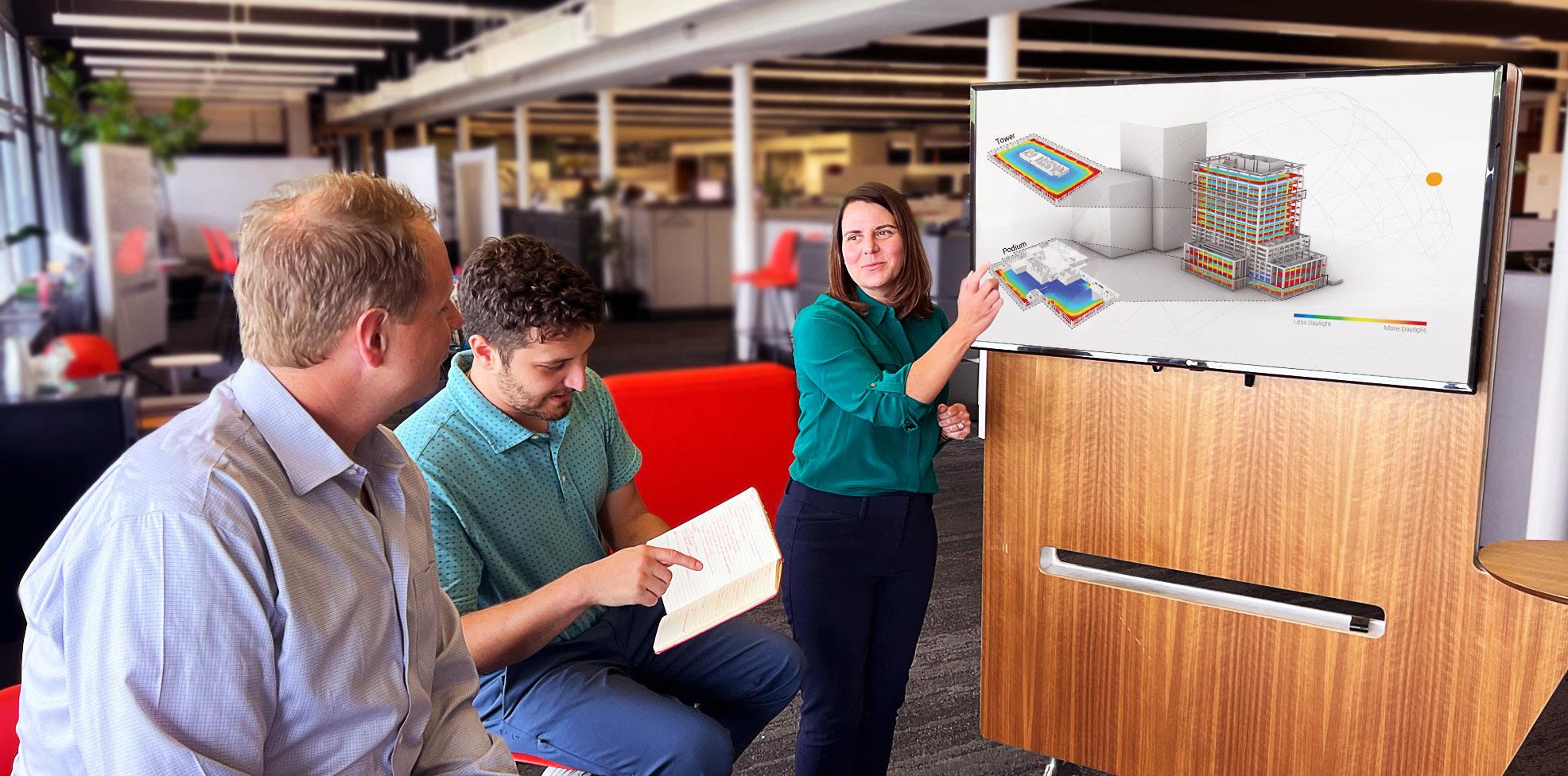
LEO A DALY Embodied Carbon Action Plan

Our GreenWorks Champions
The GreenWorks champions are a network of employees engaged in an ongoing dialogue around sustainability and high-performance. The goal is to enable a culture of sustainable design to permeate projects across regions and market sectors, so that we can quickly and earnestly address the role that the building industry plays in the most pressing challenges of the 21st century.
Kim Cowman Sustainability Lead
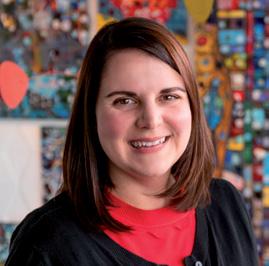
Jake Zach SE 2050 Lead

Chris Hartnett Embodied Carbon SME
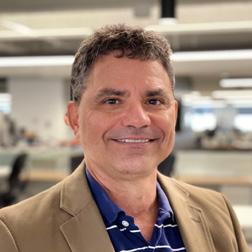
Jennifer Gustafson Responsible Materials Lead
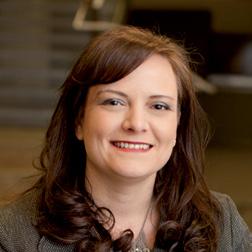
Zach Peer Architecture 2030 Lead

Nick Lassek Performance Modeling Lead

9
Knowledge Sharing
Knowledge sharing is a key part of our strategy for communicating our embodied carbon reduction work outside of the company. We believe that by sharing our efforts, successes and lessons learned with clients, the design community and the public, we can make a real difference in the fight against climate change. We are committed to weaving sustainability into everything we do, and our goal is to make embodied carbon information a central part of our brand story. By doing so, we hope to inspire others to take action on this critical issue.
Our knowledge sharing strategy uses multiple channels to reach our key audiences of clients, the design community and the public. Each one will require us to develop unique messages that speak to that audience’s concerns, and each audience will be receptive to different channels.
• Our clients need to understand how to reduce embodied carbon while achieving their project goals. We’ll develop targeted messages that demonstrate strategies we can use to reduce embodied carbon without increasing cost, and in some instances decrease cost. These messages will be delivered through channels like webinars, case studies and e-newsletters.
• The design community should work in unison to create innovative solutions. We’ll share knowledge about how we are innovating to meet our SE 2050 commitment. These messages will be delivered through channels like social media, industry conferences, trade show events and educational webinars. At the same time, we plan to continue to learn from the best practices of our industry peers.
• The general public often isn’t aware of embodied carbon. We’ll develop messaging that is informative and inspiring, delivered through channels like blog posts, info graphics and social media posts.
By using a comprehensive and targeted approach, we’ll make sure all of our key audiences are reached with the knowledge they need.
Nebraska Chapter of the Carbon Leadership Forum
LEO A DALY has served as a sponsor for the Nebraska Chapter of the Carbon Leadership Forum, leading efforts in the state to educate the local community about embodied carbon.
SE 2050 Lead Jake Zach is one of six core members of the Nebraska chapter.
In 2023, the chapter led six educational lunches in Omaha. LEO A DALY hosted one, focused on life cycle assessment programs.
Jake and the other members of the chapter will continue educational efforts in 2024 and seek to expand the chapter by adding a policy division.
This investment from LEO A DALY and other firms will advance the understanding of embodied carbon in Omaha, the home of our largest studio.
LEO A DALY Embodied Carbon Action Plan

Reduction Strategy
Our strategy for reducing embodied carbon starts with accurate tracking and benchmarking of our design portfolio. This will give us an accurate baseline of how much embodied carbon we are producing. Concurrent with this step, we are focused on updating our construction documents to include sustainability and CO2 reduction targets, based on the latest technologies researching and implementing design strategies that actively work to reduce embodied carbon.
We believe that this two-pronged approach will be the most successful in reducing our embodied carbon footprint. By accurately tracking and benchmarking our progress, we will be able to see the results of our efforts, teaming with material suppliers to specify alternative materials that reduce greenhouse gases and adjust our strategy as needed. Additionally, by actively researching and implementing design strategies that reduce embodied carbon, we will be able to have a direct impact on reducing our emissions.
Where does embodied carbon in our buildings come from?
Reduction strategies implemented to date:
• Tracking embodied carbon on select projects
• Educating our employees on embodied carbon and how to reduce
• Sharing the message of embodied carbon with clients, vendors, and industry
• Educating partnering structural firms on the benefits of reducing embodied carbon and how to account for it
• Marketing our expertise in adaptive reuse projects to add more to our portfolio
• Designing buildings for durability/flexibility to promote longer building life
Plan for future reduction:
• Select embodied carbon goals for projects in the schematic design phase
• Create a standardized bill of materials to be included in project whole building life cycle assessments

Where does it come from?


• Update specifications to include targets for embodied carbon values for specific materials (E.g.: concrete mixes)
• Conduct WBLCAs at selected project benchmarks (schematic design, design development, contract documents, as-builts)
• Consider embodied carbon in system selection during schematic design and design development
• Include specification language requiring Environmental Product Declarations to be submitted for review for select materials. (Additionally, require EPD data to come in below specified benchmarks)
• Prioritize building structure and building shell for embodied carbon considerations.
Building Structure
Building Envelope 30% Building Interior 20%
50%
11
Adaptive Reuse
Our integrated design team excels in complex adaptive reuse projects. The process of redesigning a building to support a new function utilizes our structural engineers, our systems experts, our architects and more. Our teams’ deep knowledge allows them to tackle even the most complex projects. These adaptive reuse projects create far less embodied carbon compared to demolishing and constructing a new building.
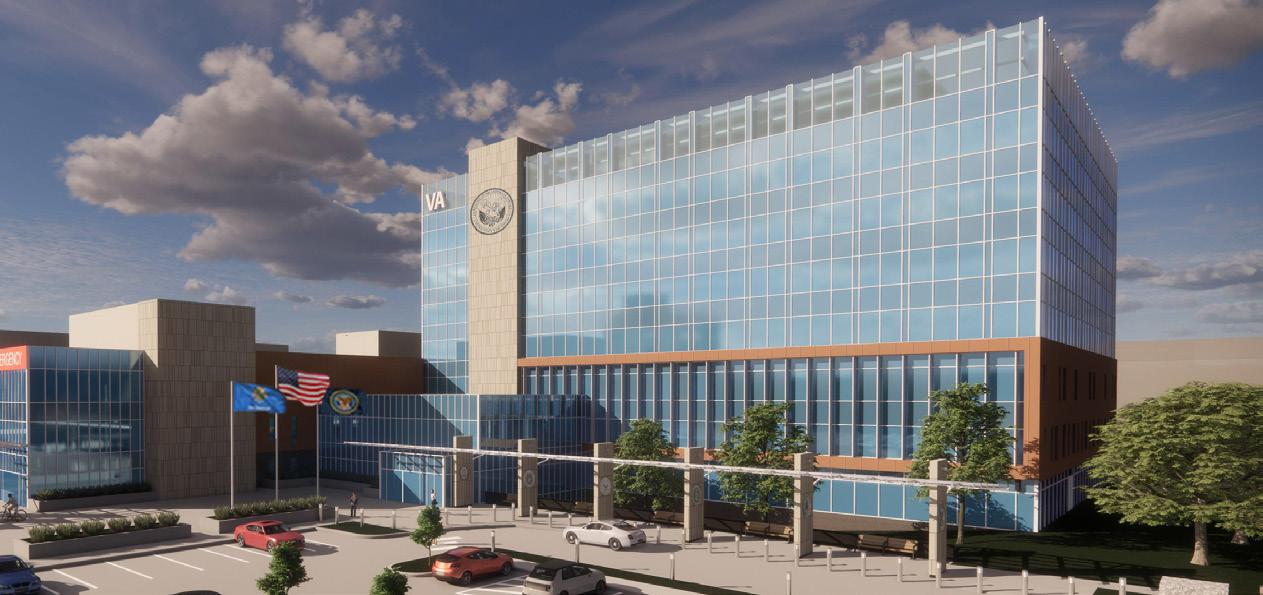
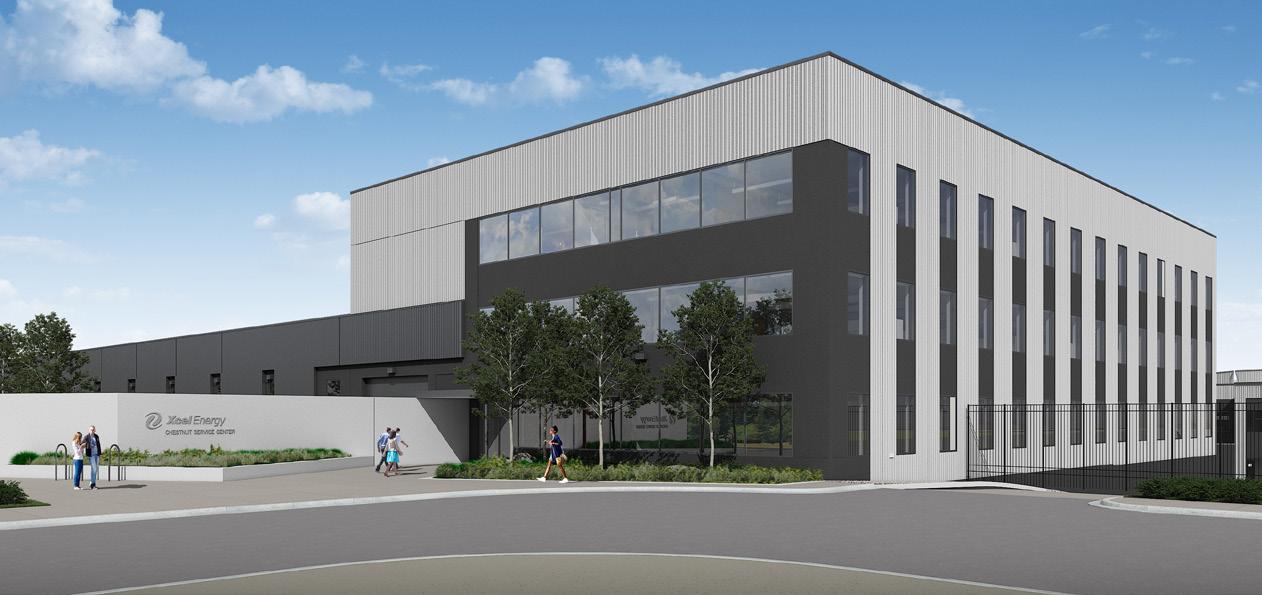
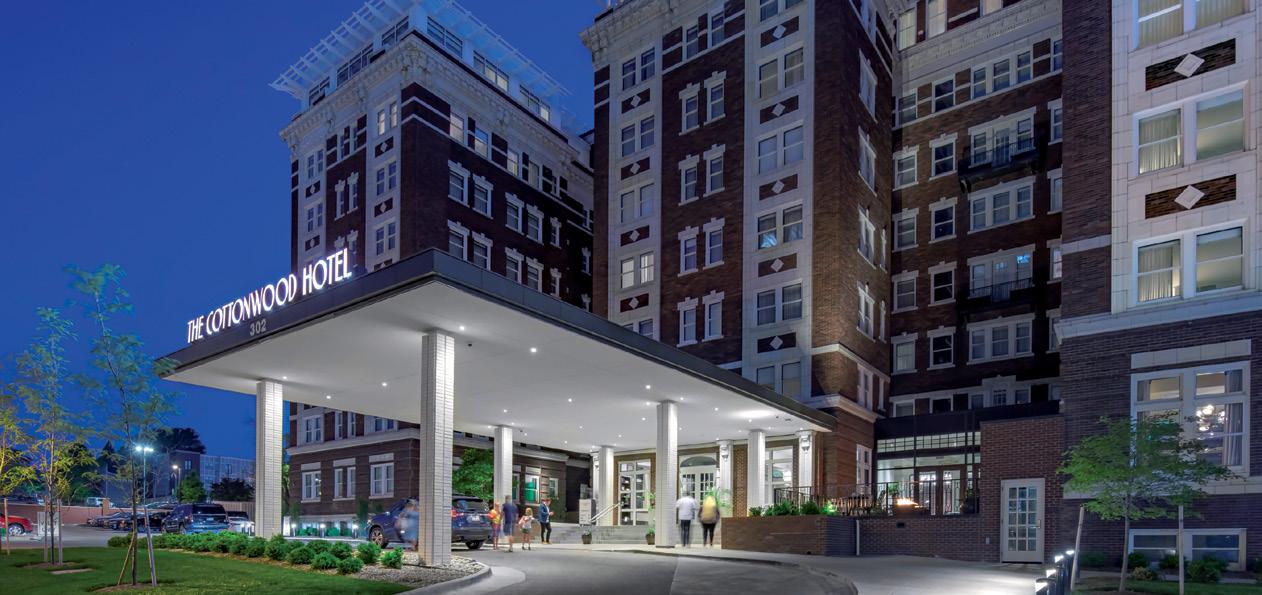
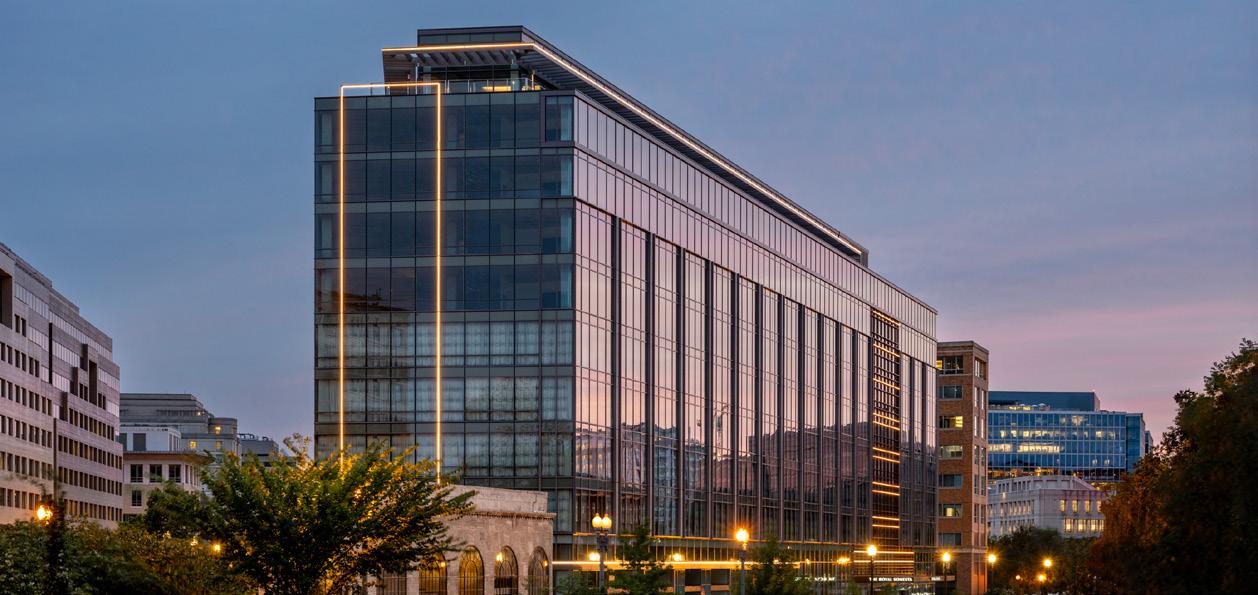
LEO A DALY Embodied Carbon Action Plan
Veterans Hospital in Tulsa Medical-Surgical Inpatient Hospital • Tulsa, OK
The Veterans Hospital in Tulsa is a $150 million adaptive reuse project transforming an office complex into a 58-bed medical-surgical inpatient hospital for the veterans of Oklahoma. The project coverts and combines two outdated office buildings to create a 300,000 sf high-performance hospital. The existing structure is a fully concrete frame system on deep foundations, including more than 15,000 tons of concrete. The includes complete renovation of all existing work environments. The project also includes a seismic force resisting system upgrade, lengthening the lifespan of the building. LEO A DALY and GH2 provided professional design services.
Embodied carbon savings vs new build: 4,500 metric tonnes of CO2eq
Equivalent to: 888 homes’ electricity use for one year
Xcel Energy Chestnut Service Center • Minneapolis, MN
This high-performance project includes a four-story office building, advanced analytical labs, and a fleet maintenance garage. These structural and varied-use combinations present unique energy design challenges. The design team guided Xcel leadership through decisions that ensure the client reaches their carbon-free commitment by 2050.
Embodied carbon savings vs new build: 2,824 metric tonnes of CO2eq
Equivalent to: 37 tanker trucks worth of gasoline
Kimpton Cottonwood Hotel • Omaha, NE
Known as the premier hotel between Chicago and San Francisco, the Blackstone Hotel was repurposed for office use in 1984. Completed in 2020, our redesign restored what is now the Kimpton Cottonwood Hotel to its former glory, now as a historic destination with modern creature comforts. Finding space for modern building systems while preserving history was a key challenge in this project. This project guts the MEP systems while maintaining a “gentle touch” toward preservation, seamlessly integrating modern building systems, elevators, commercial kitchens, guestroom controls, fast internet, and a new annex and pool club.
Embodied carbon savings vs new build: 2,023 metric tonnes of CO2eq
Equivalent to: 92,935 propane cylinders used for home barbecue
20 Mass • Washington D.C.
Developer The RMR Group challenged LEO A DALY to reimagine 20 Massachusetts Ave NW, a former federal office building, as a vibrant mixed-use development. The adaptive reuse project re-stitched the building into an evolving urban context and created a vital new social and cultural hub for the neighborhood. The resulting building combines ground-floor retail and restaurants to create a vibrant streetscape with an inviting entrance and pedestrian experience, a four-star hotel and Class-A office space with shared amenities between users, a penthouse ballroom and executive suite and an extensive green roof.
Embodied carbon savings vs new build: 6,900 metric tonnes of CO2eq
Equivalent to: 17,647,216 miles driven by an average gasoline-powered passenger vehicle
13
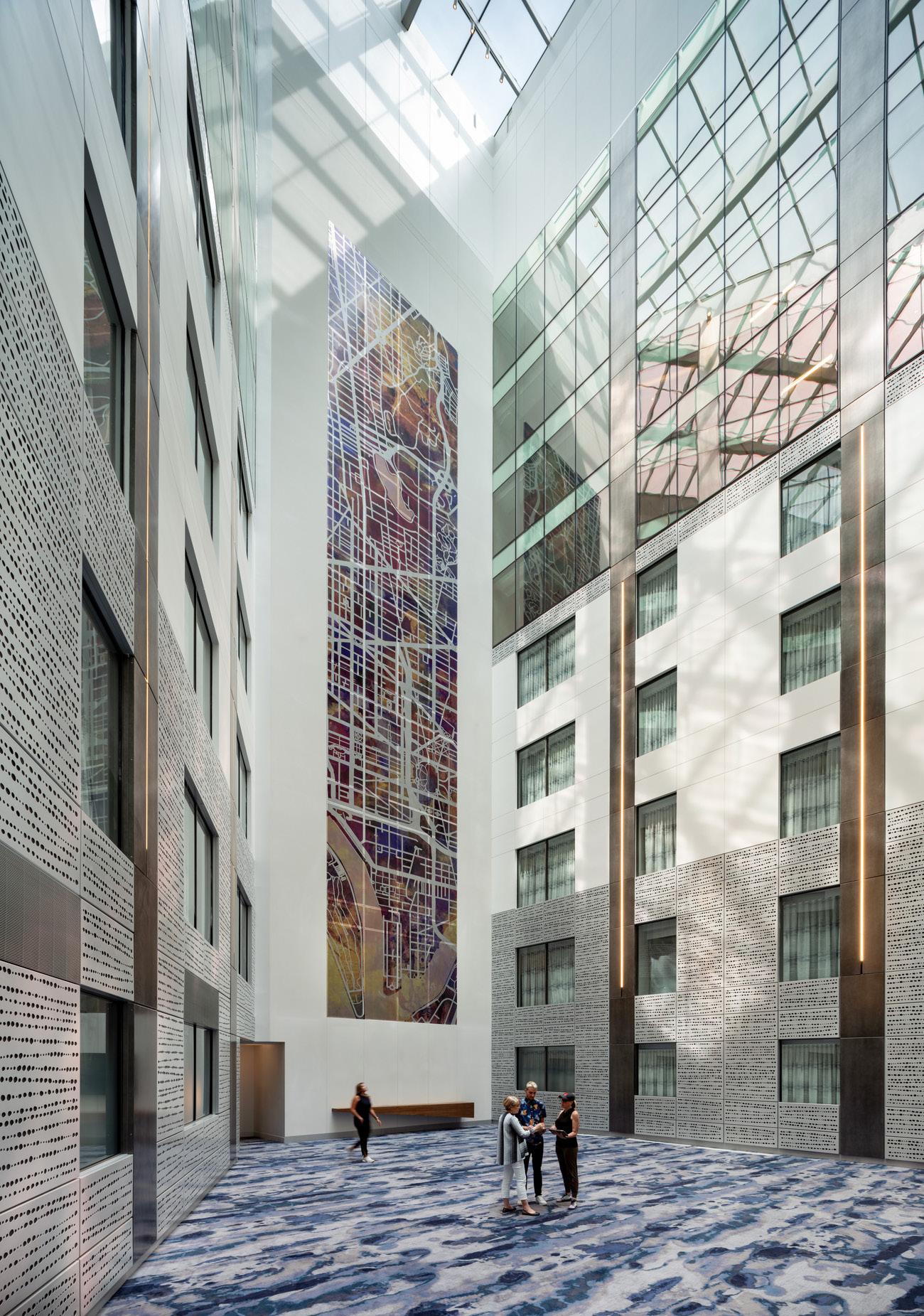




 Veterans Hospital
Xcel Energy
Xcel Energy
Kimpton Cottonwood Hotel
Kimpton Cottonwood Hotel
20 Mass
Veterans Hospital
Xcel Energy
Xcel Energy
Kimpton Cottonwood Hotel
Kimpton Cottonwood Hotel
20 Mass
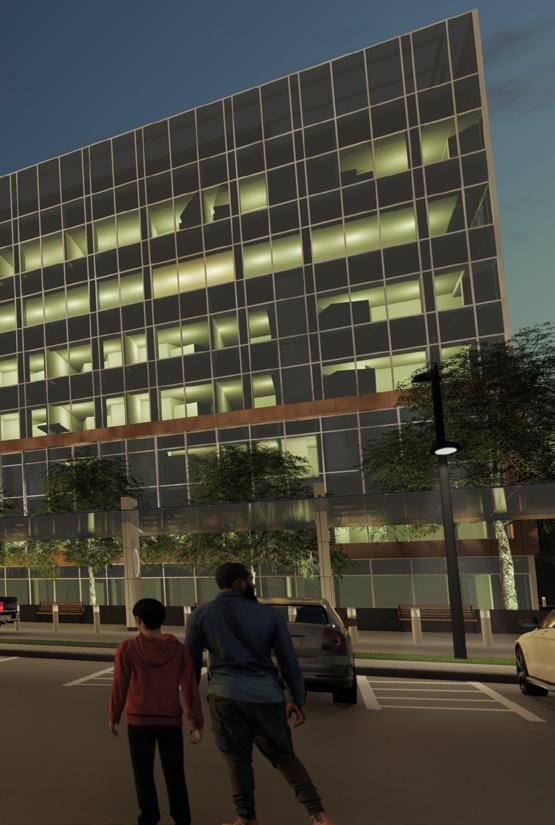

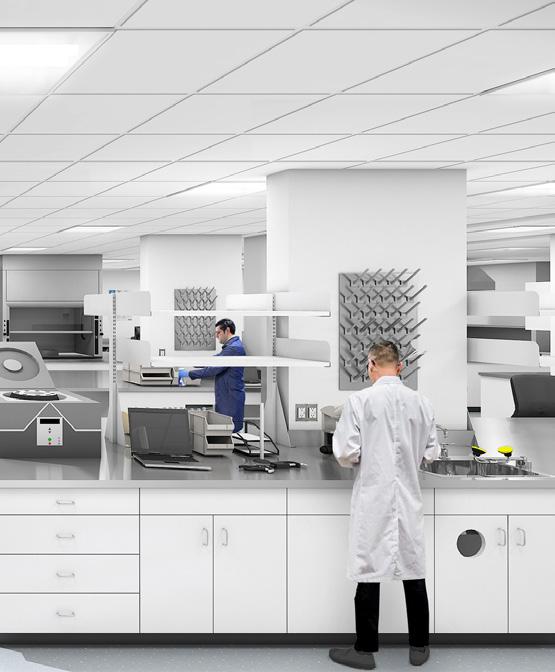


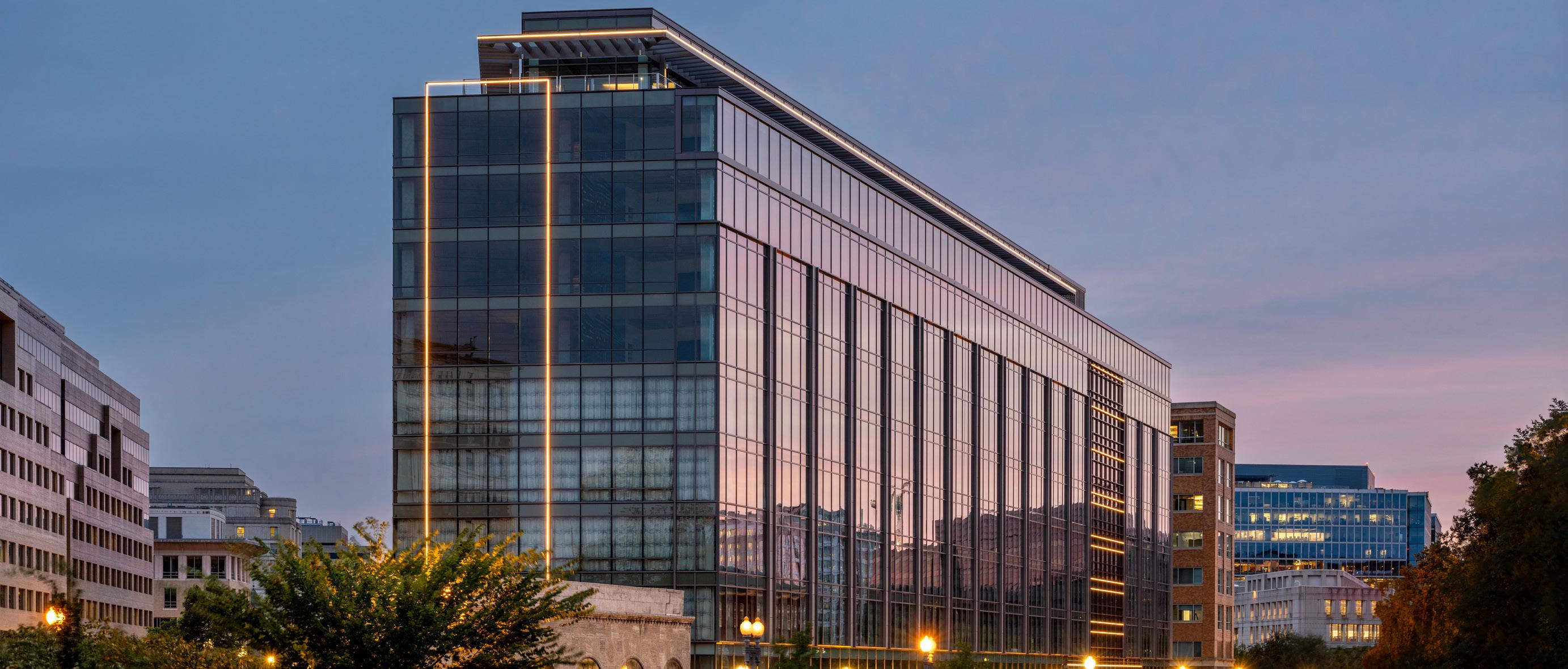
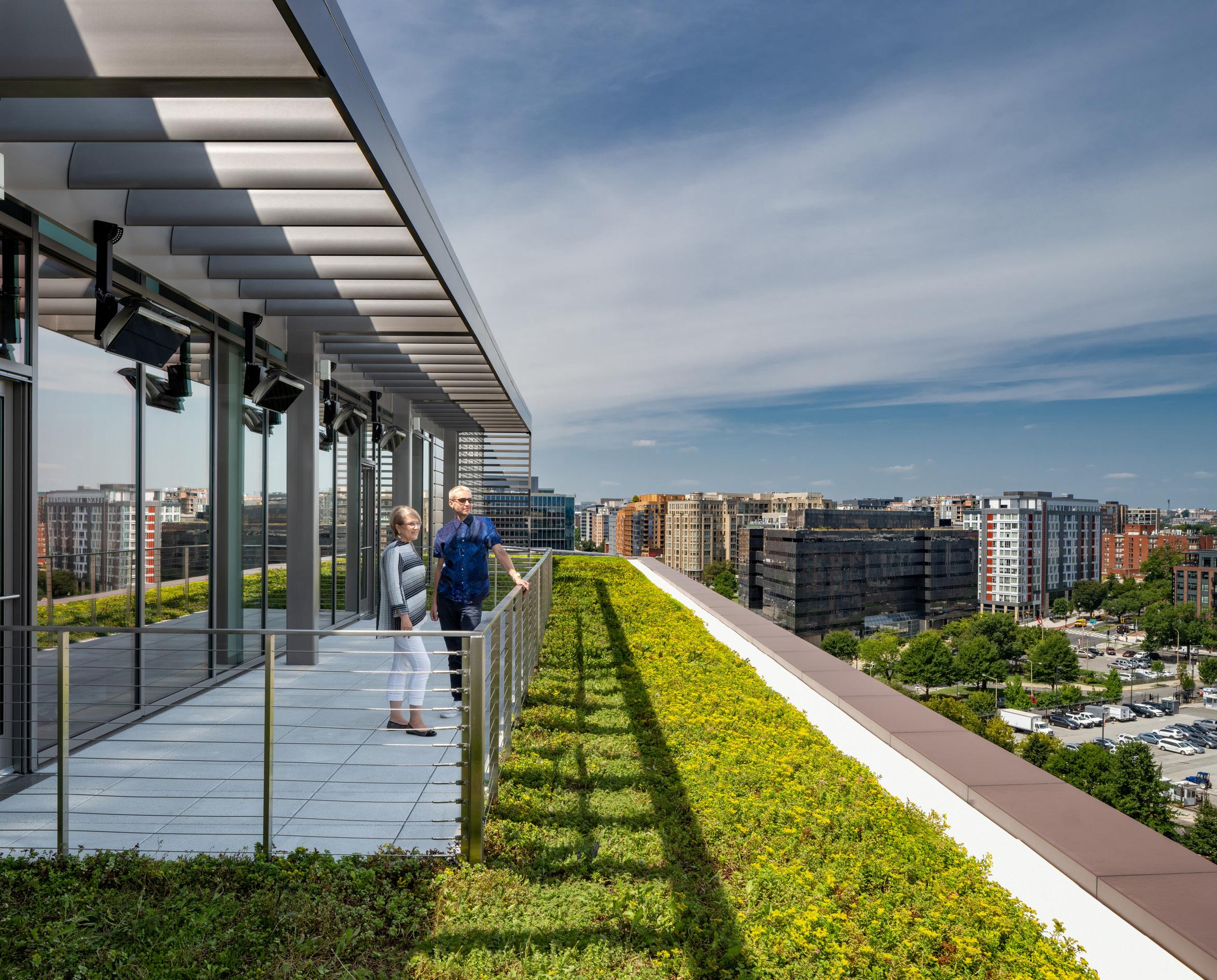
Veterans Hospital 20 Mass 20 Mass
Reporting Plan
Our efforts at tracking embodied carbon began in earnest in 2021, when we set a goal of tracking embodied carbon for six LEO A DALY projects during the year. In total we’ve tracked 17 projects, and the resulting data has been submitted to the DDX as part of our 2030 Commitment. In the process, we have developed insights that have helped improve the tracking and performance of subsequent projects.
With the signing of SE 2050, we evolved to:
• Calculate embodied carbon for structural materials using product-specific EPDs where available. If not available, we use industry averages from software programs like Tally.
• Gather EPDs using databases such as the EC3 tool by Building Transparency. We request individual project specific EPDs where appropriate on projects for materials procured.
• We use Tally to conduct life cycle assessments and quantify embodied carbon during the design stage.
• During design, our LCAs consist of systems level analysis using industry averages, including material life stages A through C. During material procurement, product level comparisons using EPDs consider stages A1-A3.
• We calculate material quantities using building information modeling, specifically Revit. Company standards outline which materials are included and which are excluded from modeling.
• We have submitted our data to the 2050 database and will continue to do so.
We have tracked and reported
3
28,000
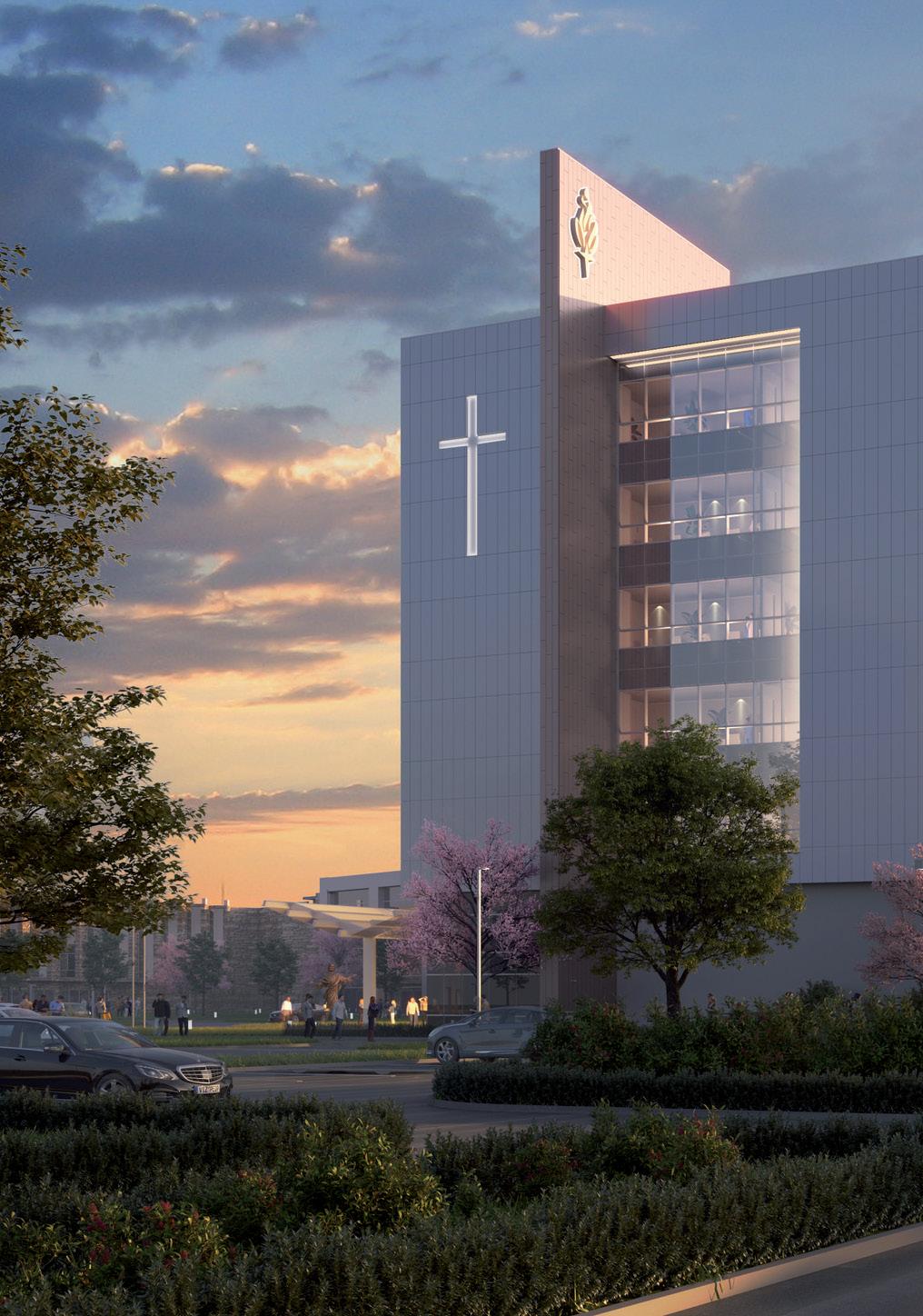
LEO A DALY Embodied Carbon Action Plan
million square feet
tons of steel
reported more than
280,000 tons of concrete
3,000 tons of masonry

Elective Documentation
In accordance with the SE 2050 guidelines, we have completed the following electives:
Education
• Present at least one webinar focused on embodied carbon and make a recording available to employees.
• Train all of our firm’s structural engineers on the core concepts and skills required to measure, reduce, and report embodied carbon.
• Initiate an embodied carbon interest group within our firm and outline our goals.
• Engage with a CLF regional hub.
Reporting
• Submit a minimum of two projects per U.S. studio with structural engineering services to the SE 2050 Database.
• Include all structural material quantities in our submissions to the SE 2050 database.
Reduction
• Update our specifications to incorporate embodied carbon performance. Include embodied carbon in our submittal review requirements.
• Compare different design options with embodied carbon as a performance metric during the project concept phase. Explain what we did and what the results changed (if anything).
• Participate in a LEED, ILFI Zero Carbon, or similar project design charrette and speak to potential design considerations impacting embodied carbon.
Advocacy
• Publicly declare our firm as a member of the SE 2050 Commitment.
• Give an external presentation on embodied carbon that demonstrates a project success or lessons learned. Get connected at a CLF regional hub near you and be sure to post the recording.
• Engage with structural material suppliers in our region to communicate the importance of Environmental Product Declarations (EPDs) and low-carbon material options.
17
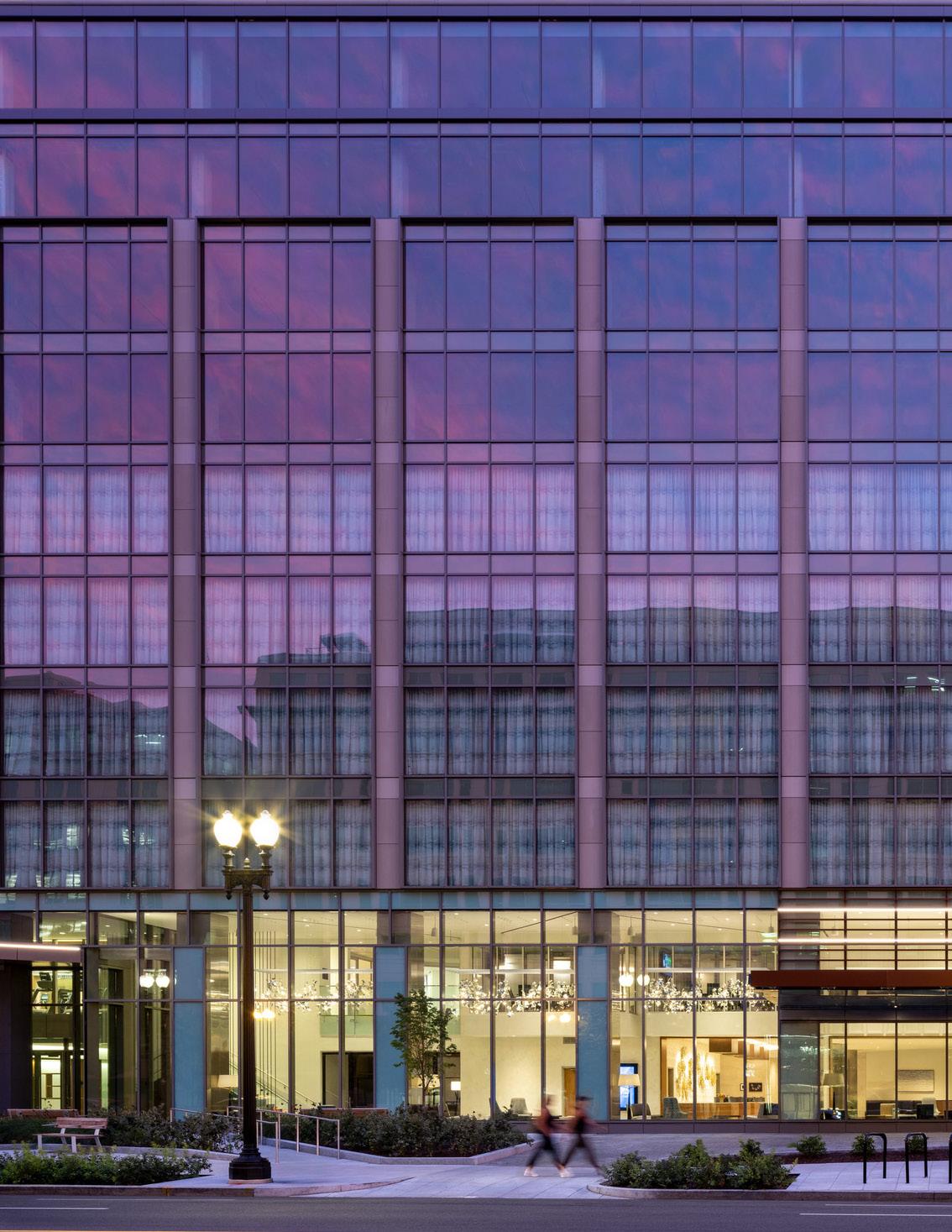
PLANNING ARCHITECTURE ENGINEERING INTERIORS leoadaly.com 8600 Indian Hills Drive Omaha, NE 68114-4039 402.391.8111
back:
Massachusetts Avenue, Washington, D.C.
Front and
20




 Steven A. Lichtenberger, AIA, NCARB, LEED AP President, LEO A DALY
Steven A. Lichtenberger, AIA, NCARB, LEED AP President, LEO A DALY
























 Veterans Hospital
Xcel Energy
Xcel Energy
Kimpton Cottonwood Hotel
Kimpton Cottonwood Hotel
20 Mass
Veterans Hospital
Xcel Energy
Xcel Energy
Kimpton Cottonwood Hotel
Kimpton Cottonwood Hotel
20 Mass









